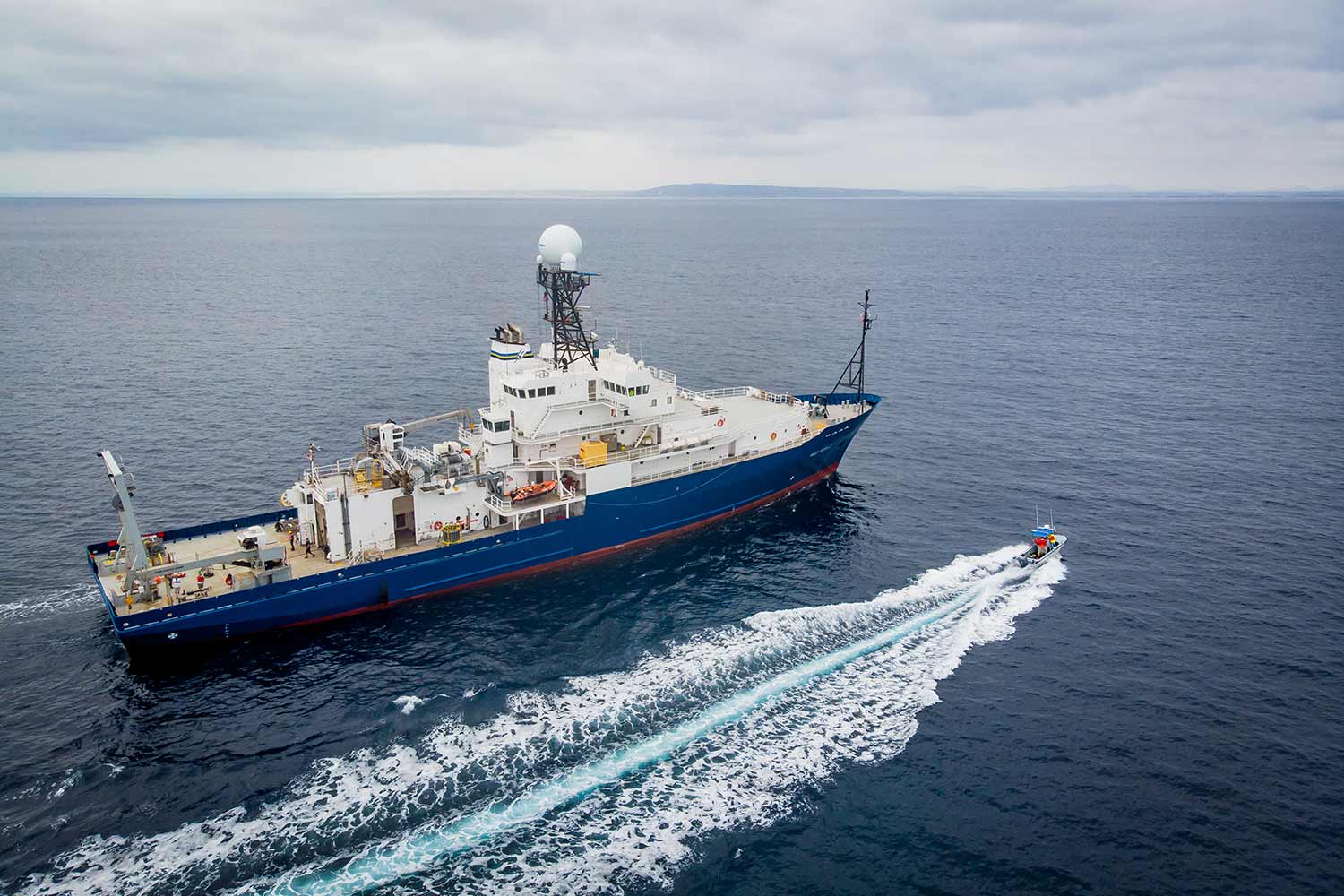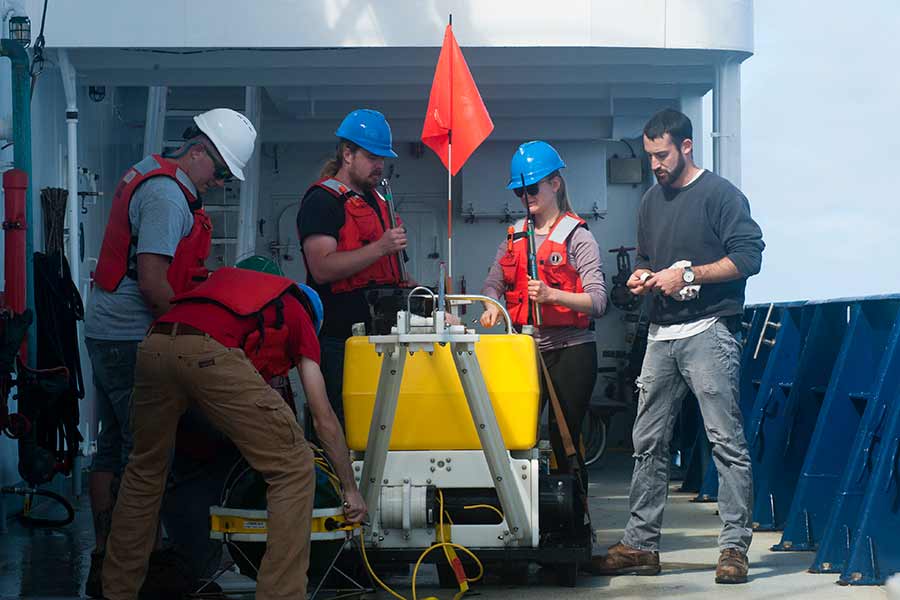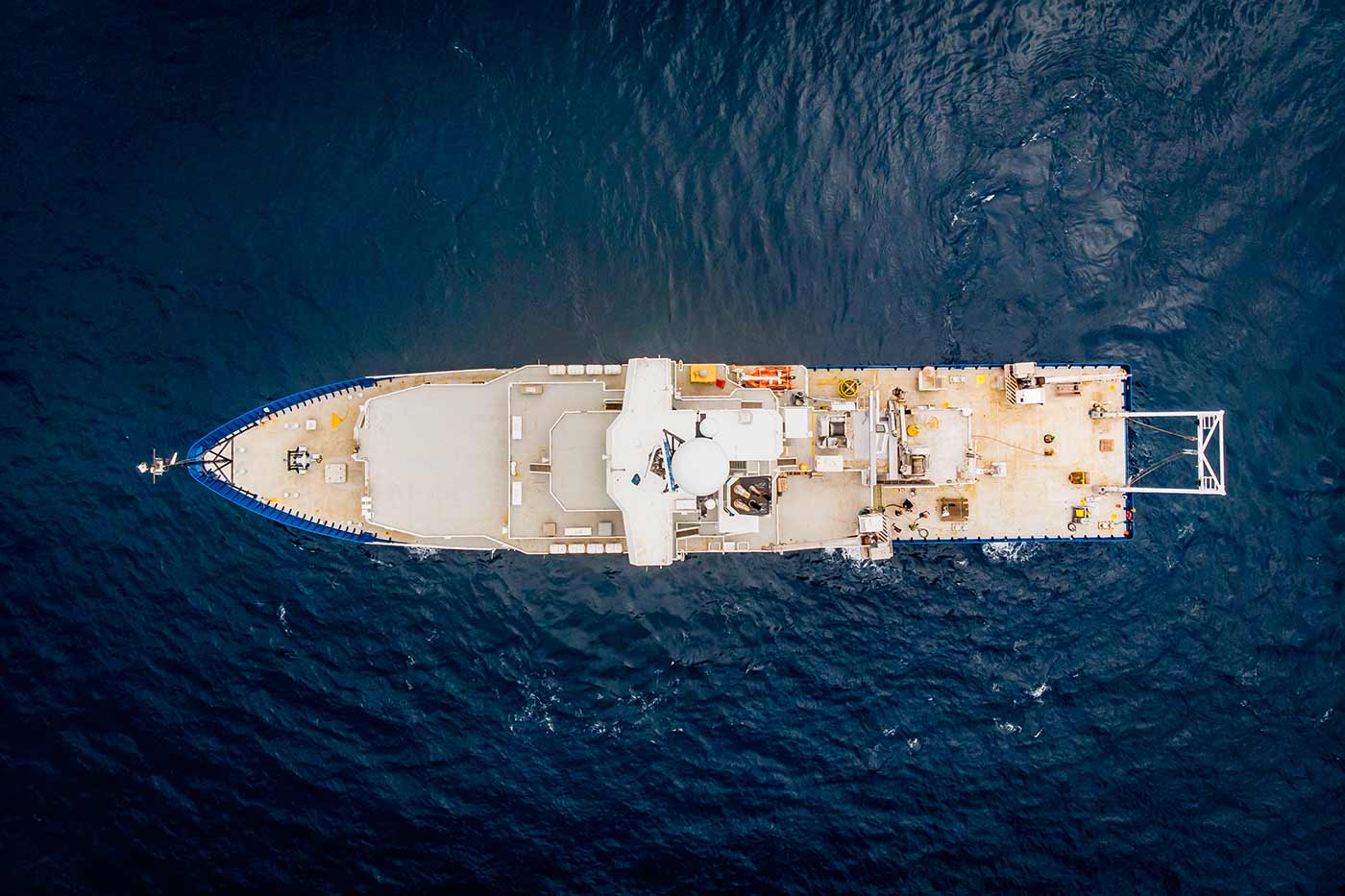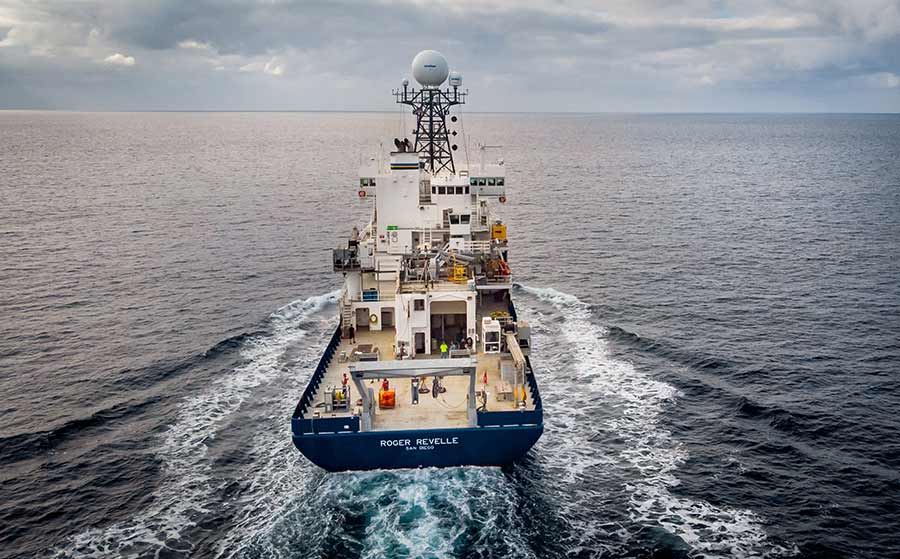
By:
- Lauren Fimbres Wood
Published Date
By:
- Lauren Fimbres Wood
Share This:

Research Vessel Roger Revelle heads back to sea after the completion of the midlife refit, which will extend the service life of the ship by up to 20 years.
Midlife Refit of Research Vessel Roger Revelle Completed
Upgrades improve scientific capabilities and extend life of one of the most capable ships in U.S. academic fleet
Research vessel (R/V) Roger Revelle is back at work after a midlife refit involving upgrades from top to bottom, bow to stern. The primary goal of extending the service life by 15 to 20 years was accomplished with improvements to systems crucial to the vessel’s operations, scientific capabilities, habitability, and environmental footprint.
The ship is owned by the Office of Naval Research and has been operated by Scripps Institution of Oceanography at the University of California San Diego since 1996. It is one of the largest ships in the U.S. Academic Research Fleet, and vitally important to U.S. oceanographic research due to its range, payload, duration and ability to safely conduct scientific operations in remote areas around the globe.
“Roger Revelle isn't just revitalized, it is better than new,” said Bruce Appelgate, associate director and head of ship operations at Scripps Oceanography. “The midlife refit was an opportunity to apply everything we've learned about the ship since 1996, in order to make a great research vessel even more effective.”

The first research expedition on the all-new R/V Roger Revelle got underway in early November, in an essential research mission to retrieve ocean bottom seismometers measuring seismic activity and to collect rocks from seamounts and underwater volcanoes. Photo credit: Helen Janiszweski.
The $60 million refit, which includes the base refit cost and investment in scientific systems and instrumentation, was supported by the Office of Naval Research (ONR), National Science Foundation (NSF) and UC San Diego.
“The partnership between the National Science Foundation and the Office of Naval Research in supporting the global class vessels is one of the most important federal alliances the Division of Ocean Science has made in safeguarding our critical sea-going science missions,” said Rose Dufour, NSF Program Director.
Upgrades to R/V Roger Revelle include the addition of diesel engines that reduce emissions by up to two-thirds, ballast water systems designed to protect against the spread of invasive species, and the use of heat captured from the ship’s engine to desalinate seawater. These upgrades are the latest reflection of an ongoing effort throughout the U.S. Academic Research Fleet to reduce the environmental impact of ships.
An innovative extendable bow thruster has been installed that can be lowered beneath the ship to deliver thrust in any direction. This provides more power and quieter operations compared to the original bow thruster. Coupled with the ship’s dynamic positioning system, the new thruster enables it to maintain precise positioning and improves maneuverability when coming into port.
The ship’s overboard handling systems also got an overhaul, with new cranes and a completely refurbished A-frame and hydrographic boom used to deploy and recover scientific instruments while at sea.
Upgraded network capabilities support the significant amount of data collected from these instruments. A new virtual desktop infrastructure (VDI) includes display consoles for all systems throughout the ship, reducing the workload for scientists and crew members alike who use these during their operations. New cyberinfrastructure and centralized computer management helps the ship’s technicians maintain security and reliability of onboard computing and networking.
Another major upgrade was the addition of the acoustics gondola secured below the keel. This new position results in significantly improved sonar performance, enabling operations to continue even in high sea states. Acoustic systems are used to profile the subsurface, identify animals in the water column, track subsurface vehicles, and measure ocean currents. They are also used to map the seafloor, a capability much desired by the renewed effort to map the U.S. Exclusive Economic Zone through the Federal National Ocean Mapping, Exploration, and Characterization (NOMEC) Strategy, which NSF and ONR help lead. R/V Roger Revelle will now have the most sophisticated mapping capabilities in the U.S. Academic Research Fleet.

The vessel features new cranes and a completely refurbished A-frame and hydrographic boom used to deploy and recover scientific instruments while at sea.
Inside the ship’s laboratories, reconfigurable tables feature an innovative nesting design that allows for practical and efficient use of space for scientists with a variety of needs. Improving the living and recreation spaces for everyone on board was important during the overhaul as well, particularly for crew members who make the ship their home for months at a time. Upgrades to living spaces include new carpets, bed curtains and flooring.
The overhaul of the vessel was conducted in Portland, Ore., by Vigor Shipyard. R/V Roger Revelle returned to its home port of San Diego in July, where Scripps Oceanography technicians worked under UC San Diego’s enhanced safety protocols to complete the work.
The ship was put into service in 1996. It honors former Scripps Oceanography Director Roger Revelle, who is widely regarded for not only establishing the institution as an internationally prominent science center, but for solidifying the decades-long relationship between Scripps Oceanography and the U.S. Navy.
“Roger Revelle was a visionary who—back in 1946—envisioned the Office of Naval Research as a world leader in sponsoring oceanographic basic research, and later foresaw the need for a new University of California in La Jolla that eventually grew around Scripps,” said Tom Drake, director of the Ocean Battlespace and Expeditionary Access department at the Office of Naval Research. “He also suggested the likely trajectory of the Earth’s climate, which we are now observing.”
Revelle served as an oceanographer for the U.S. Navy during World War II and was instrumental in the founding of the Office of Naval Research. He worked at Scripps Oceanography before and after the war and served as its director from 1950 to 1964. He was among the first to consider the implications of the accumulation of carbon dioxide in the atmosphere and absorption rates of the greenhouse gas by the ocean.
A continuous profiling system under the ship will also measure carbon dioxide in seawater, an essential component of ocean acidification research.

Research Vessel Roger Revelle first entered service in 1996, and is named after former Scripps Oceanography Director Roger Revelle, who was also instrumental in the founding of the Office of Naval Research.
"The revitalization of R/V Roger Revelle will enable even more scientific discoveries at sea to further our understanding of our planet,” said Margaret Leinen, Vice Chancellor for Marine Sciences at UC San Diego and director of Scripps Oceanography. “We appreciate the continued leadership from Congress to build and renovate the U.S. research fleet."
The first research expedition on the all-new R/V Roger Revelle got underway in early November. This essential research mission, led by Zach Eilon of UC San Santa Barbara and Helen Janiszweski of University of Hawaii, is retrieving ocean bottom seismometers measuring seismic activity and collecting rocks from seamounts and underwater volcanoes. The ship has already crossed the equator and is putting the upgraded acoustic systems to use while recovering these instruments.
The second research cruise begins on Christmas day, during which R/V Roger Revelle travels to the Southern Ocean. The ship’s handling systems will be put through their paces as scientists collect samples, photographs, and sensor data to learn about plankton concentrations in eddies that form in the Southern Pacific. This 60-day expedition led by Barney Balch of the Bigelow Laboratory for Ocean Sciences East Boothbay Harbor (Maine) will also deploy biogeochemical floats for the Southern Ocean Carbon and Climate Observations and Modeling project, a multi-institution program focused on unlocking the mysteries of the Southern Ocean and determining its influence on climate.
“While the enduring connection between the Navy and Scripps is manifest in the vessel’s namesake, this service life extension will serve multiple agencies, academic institutions and inspire the next generation of ocean-going scientists,” said Rob Sparrock, program officer with the Office of Naval Research who oversees the research vessel program.
Appelgate said the refit illustrates the continued value of seagoing research vessels even as remote and autonomous observing platforms proliferate to compliment ship-based research.
“Shipboard research offers the transformative potential to understand global change and monitor the health of ocean ecosystems, while training the next generation of sea-going scientists and technicians,” Appelgate said.
The home port of R/V Roger Revelle is the Nimitz Marine Facility in San Diego, where the vessel is maintained as part of the Scripps oceanographic research fleet alongside the Navy-owned and Scripps-operated R/V Sally Ride, the University of California-owned R/V Robert Gordon Sproul, R/VBob and Betty Beyster, and Research Platform FLIP (FLoating Instrument Platform).
Share This:
You May Also Like
Stay in the Know
Keep up with all the latest from UC San Diego. Subscribe to the newsletter today.


